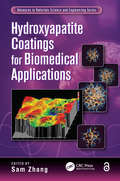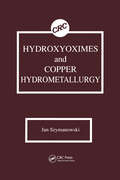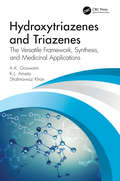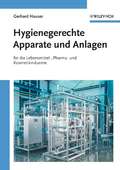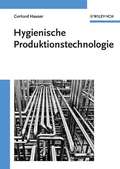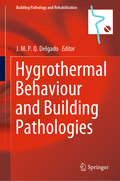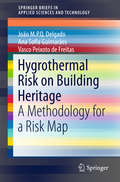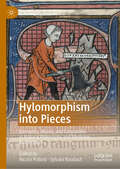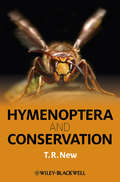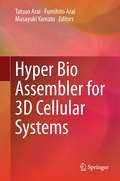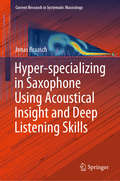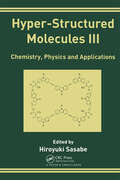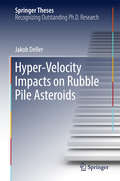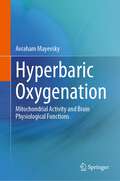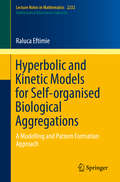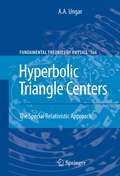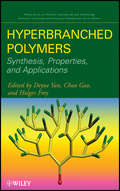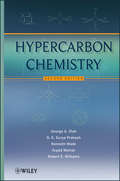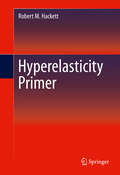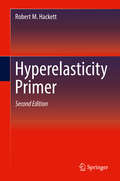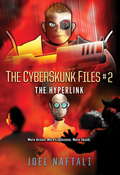- Table View
- List View
Hydroxyapatite Coatings for Biomedical Applications (Advances In Materials Science And Engineering Ser.)
by Sam ZhangHydroxyapatite coatings are of great importance in the biological and biomedical coatings fields, especially in the current era of nanotechnology and bioapplications. With a bonelike structure that promotes osseointegration, hydroxyapatite coating can be applied to otherwise bioinactive implants to make their surface bioactive, thus achieving faster healing and recovery. In addition to applications in orthopedic and dental implants, this coating can also be used in drug delivery. Hydroxyapatite Coatings for Biomedical Applications explores developments in the processing and property characterization and applications of hydroxyapatite to provide timely information for active researchers and newcomers alike. In eight carefully reviewed chapters, hydroxyapatite experts from the United States, Japan, Singapore, and China present the latest on topics ranging from deposition processes to biomedical applications in implants and drug delivery. This book discusses: Magnetron sputtering and electrochemical deposition The modification of hydroxyapatite properties by sol–gel deposition to incorporate other elements found in natural bones, such as zinc, magnesium, and fluorine The use of pure hydroxyapatite in drug delivery applications The growth or self-assembly of hydroxyapatite on shape memory alloy Hydroxyapatite composite coatings—with carbon nanotubes, titanium dioxide (TiO2), and others—on the titanium alloy Offering valuable insights and a wealth of data, including numerous tables and figures, this is a rich source of information for research on hydroxyapatite coatings. Each chapter also covers material that provides an accessible stepping stone for those who are new to the field.
Hydroxyoximes and Copper Hydrometallurgy
by Jan SzymanowskiHydroxyoximes and Copper Hydrometallurgy provides a current examination of what is known regarding hydroxyoxime extractants, the chemistry and physicochemistry of extraction, and the potential of applying hydroxyoximes for extraction of copper and other metals in industrial processes. Topics addressed include the development of the hydrometallurgical process, methods of synthesis and structural characteristics, extraction properties, losses of active substances and problems associated with environmental pollution, the potential of metal extraction and separation with hydroxyoximes, methods of extraction and stripping that can improve metal separation and recovery, the applications of hydroxyoximes in various membrane processes, and industrial processes and equipment used for processing oxide ores and tailing. The book will benefit metallurgists, hydrometallurgists, analytical and physical chemists, and researchers in mining industries and solvent extraction.
Hydroxytriazenes and Triazenes: The Versatile Framework, Synthesis, and Medicinal Applications
by A.K. Goswami K. L. Ameta S. KhanOrganic chemistry research has moved rapidly toward synthesis and medicinal application of nitrogen-containing compounds such as triazenes, triazines, and hydroxytriazenes due to their excellent biological activities. Many of them are presently in clinical trials. Triazene compounds have excellent medicinal properties and limited toxicity. Hydroxytriazenes are excellent chelating agents for transition metals. Newer studies show very promising biological and medicinal applications of these classes of compounds. Hydroxytriazenes and Triazenes: The Versatile Framework, Synthesis, and Medicinal Applications highlights synthetic methods, recent advances, and potential applications of triazines, triazenes, and hydroxytriazenes. This book includes holistic information on synthetic methods for novel compounds based on this moiety, up-to-date information on the how and why of their diverse or even multitargeted medicinal application, and future state of the art of both aspects. Other features include: Highlights recent advances and diverse possible applications of biological functions Covers the chemistry of triazine, triazene, and hydroxytriazene systems On the basis of in silico predictions, the book highlights synthetic methods and their applications A valuable source of information for those actively engaged in medicinal chemistry, drug discovery, and synthetic organic chemistry
The Hyena Scientist (Scientists in the Field Series)
by Sy Montgomery Nic BishopThis myth-busting new addition to the critically acclaimed Scientists in the Field series by Sibert medal winning team Sy Montgomery and Nic Bishop is perfect for nonfiction readers looking for more female scientist narratives, or a fresh perspective on an underrepresented animal—Hyenas! Timely and inspiring, The Hyena Scientist sets the record straight about one of history’s most hated and misunderstood mammals, while featuring the groundbreaking, pioneering research of a female scientist in a predominately male field in this offering by Sibert-winning duo Sy Montgomery and Nic Bishop. As a scientist studying one of the only mammalian societies led entirely by females, zoologist Kay Holecamp has made it her life’s work to understand hyenas, the fascinating, complex creatures that are playful, social, and highly intelligent—almost nothing like the mangy monsters of pop culture lore.
Hygienegerechte Apparate und Anlagen: In der Lebensmittel-, Pharma- und Kosmetikindustrie
by Gerhard HauserIn der Lebensmittel-, der kosmetischen, pharmazeutischen und chemischen Industrie sowie in der Biotechnologie ist zum Schutz vor Kontamination ein hygienischer Produktionsprozess sehr wichtig. Sichere Qualitatsprodukte lassen sich nur mit Anlagen herstellen, die sich zuverlassig reinigen lassen. Deshalb spielt bei der Herstellung hochreiner Produkte "Hygienic Design" moderner Anlagen, Apparate, Komponenten und Prozessraume eine entscheidende Rolle. In allen Industriezweigen konnen dadurch erhebliche Kosten fur den Reinigungsaufwand und zur Reduzierung der Umweltbelastung eingespart werden. Das vorliegende Werk baut auf dem Buch Hygienische Produktionstechnologie auf und beschreibt die Komponenten und Bauteile, die fur die Konstruktion hygienegerechter Apparate und Anlagen benotigt werden. Es richtet sich besonders an Ingenieure im konstruktiven Bereich in der Lebensmittel-, Pharma- und Kosmetikindustrie, aber auch an Betriebsangehorige, die fur Qualitat, Risikoanalysen und Produktsicherheit bei der Produktherstellung verantwortlich sind.
Hygienisch-mikrobiologische Wasseruntersuchung in der Praxis: Nachweismethoden, Bewertungskriterien, Qualitätssicherung, Normen
by Irmgard Feuerpfeil Konrad BotzenhartAlle g ngigen mikrobiologischen Nachweismethoden sind hier f r den Praktiker zusammengestellt. Sie werden mit Hilfe von Flu diagrammen und Referenzergebnissen leicht nachvollziehbar erkl rt. Zu jedem Nachweis werden die gesetzlichen Anforderungen und Bewertungsma st be erl utert - sowohl auf nationaler wie auf EU-Ebene. Damit ist das Werk eine sinnvolle Erg nzung der DEV-Loseblattsammlung. Unverzichtbar f r alle, die Wasseruntersuchungen in Auftrag geben, durchf hren oder bewerten wollen.
Hygienische Produktionstechnologie: Band 1: Hygienische Produktionstechnologie. Band 2: Hygienegerechte Apparate Und Anlagen
by Gerhard HauserBei der Herstellung hochreiner Produkte spielt Hygienic Design moderner Anlagen, Apparate, Komponenten und Prozessraume eine entscheidende Rolle. Die Lebensmittel-, Futtermittel-, Pharma-, Kosmetik- und Bioindustrie sind aus hygienischen Grunden, die Chemische- und Farbenindustrie aus Grunden der Produktreinheit auf einwandfreie Sauberkeit ihrer Prozesseinrichtungen angewiesen. Durch Optimierung der Reinigbarkeit lassen sich bei Produkten, die fur den menschlichen Konsum bestimmt sind, Kontaminationen und Ruckrufaktionen vermindern bzw. vermeiden und Anforderungen des Verbraucherschutzes leichter erfullen. In allen Industriezweigen konnen durch Hygienic Design erhebliche Kosten fur den Reinigungsaufwand und zur Reduzierung der Umweltbelastung eingespart werden. Das vorliegende Buch gibt u.a. Antworten auf folgende Fragen: Welche Regelungen, Leitlinien und Normen zur Gestaltung unter hygienischen bzw. reinigungstechnischen Gesichtspunkten sind verfugbar und verpflichtend? Was ist Stand der Technik? Welches sind grundlegende Problembereiche? Welche konstruktiven Verbesserungen sind moglich? Neben rechtlichen Anforderungen werden theoretische Grundlagen, Fragen des Einsatzes von Werkstoffen, notwendige Oberflachenqualitaten sowie hygienegerechte Dichtungs- und Maschinenelemente diskutiert. Fur Anlagen, Apparate, Komponenten, Prozessumgebung und raumliche Ausstattungen werden anhand vieler konstruktiver Praxisbeispiele Schwachstellen und Problembereiche sowie Moglichkeiten zu deren Verbesserung dargestellt. Das Buch richtet sich an Ingenieure im konstruktiven Bereich der genannten Industriezweige im Anlagenbau und in der Zulieferindustrie. Betriebsangehorige, die fur Risikoanalysen, Qualitat und Produktsicherheit bei der Produktherstellung verantwortlich sind, erhalten viele praktische Hinweise auf apparatives Design.
Hygrothermal Behaviour and Building Pathologies (Building Pathology and Rehabilitation #14)
by J. M. P. Q. DelgadoThis book presents recent research in the area of construction pathology, hygrothermal behaviour of buildings, service life and diagnostic techniques, and highlights the latest developments in building physics, hygrothermal behaviour, durability and numerical models applied to building materials analysis. Discussing the state of the art in the field, and covering topics relevant to variety of engineering disciplines, such as civil, materials and mechanical engineering, it will appeal to scientists, students, practitioners, lecturers and other stakeholders.
Hygrothermal Risk on Building Heritage
by João M. P. Q. Delgado Ana Sofia Guimarães Vasco Peixoto FreitasThis book presents a critical review of a criterion of risk, created to assess the flood risk to heritage buildings, and evaluates this criterion by applying it to the sample Portuguese heritage buildings. In a first approach, the total number of potential parameters is effectively reduced and the selected criteria are divided into two different groups: the monument's location in relation to a waterway, and the behaviour of its construction material in contact with water. Above all, the book discusses the importance of architectural heritage and argues for the need to safeguard it from extreme climatic phenomena such as floods. As such, the book vividly reminds the scientific community that the intensification of the global warming and climate change will worsen throughout the 21st century, and that it is therefore necessary to adopt preventive measures to minimize, mitigate and control these adverse effects if we hope to avoid catastrophic consequences. At the same time, the book takes into account a broad range of scientific and engineering disciplines, such as civil engineering and architecture, offering a synthesis of the current state of knowledge to benefit and guide experts and practitioners in related fields.
Hylomorphism into Pieces: Elements, Atoms, and Corpuscles in Natural Philosophy and Medicine, 1400–1600 (Palgrave Studies in Medieval and Early Modern Medicine)
by Nicola Polloni Sylvain RoudautFocussing on late medieval and early modern philosophy and medicine, this edited collection explores the replacement of hylomorphism—the dominant theory of bodies in the Middle Ages—with new theories of matter such as corpuscularianism and atomism at the dawn of the Modern period. Together, the contributions offer a comprehensive overview of a crucial historical moment for the history of philosophy and science: the rise of a new conception of matter against declining scholastic theories. They highlight the key aspects of this historical transition by investigating precise concepts that were central to this shift, namely the notions of elements, atoms, and corpuscles. Shedding light on the gradual process by which hylomorphism was eventually replaced by a more positive conception of matter and natural processes, the book demonstrates how many thinkers of the late medieval period were willing to integrate new theories into the conceptual framework of Aristotelian natural philosophy, and tried to harmonise them with the traditional concepts and axioms of scholastic doctrines. Showing how these conceptual innovations resulted from a complex interaction between different fields of late medieval and early modern knowledge, the authors bring together research from the disciplines of metaphysics, medieval philosophy, and medical science. Providing an overview of an important theoretical shift in the transition from the Middle Ages to the Modern Era, this book is essential reading for scholars of philosophy, and historians of medieval and early modern science and medicine.
Hymenoptera and Conservation
by T. R. NewHymenoptera, the bees, wasps and ant, are one of the largest insect orders, and have massive ecological importance as pollinators and as predators or parasitoids of other insects. These roles have brought them forcefully to human notice , as governors of some key ecological services that strongly influence human food supply. Recent declines of pollinators and introductions of alien pests or biological control agents are only part of the current concerns for conservation of Hymenoptera, and of the interactions in which they participate in almost all terrestrial ecosystems. Both pests and beneficial species abound within the order, sometimes closely related within the same families. Many taxa are both difficult to identify, and very poorly known. This global overview, the first such account for the whole of the Hymenoptera, discusses a broad range of themes to introduce the insects and their conservation roles and needs, and how their wellbeing may be approached. The book is intended as a source of information for research workers, students, conservation managers and naturalists as an introduction to the importance of this dominant insect order.
Hymn of the Universe
by Pierre Teilhard De ChardinIn this book it is almost always Pere Teilhard, the man of prayer rather than the man of science, who speaks to us. As Sir Julian Huxley wrote of The Mass on the World, it is a 'truly poetical essay ... at one and the same time mystical and realistic, religious and philosophical'. This does not mean, of course, that the author ever forgets or betrays his science; what it does mean is: that the reader's approach, and response, to these pages must of necessity be quite different from those demanded by the scientific works. The mystic, the poet use language in a way essentially different from that of the scientist.
Hypatia von Alexandria
by Laurel A. RockefellerAls die westliche Welt in Dunkelheit versank, wagte sie, das Licht zu verteidigen. Geboren im Jahr 355 der christlichen Zeitrechnung, im Nachhall von Konstantins Regierung, lebte Hypatia von Alexandria in einem zusammenbrechenden Römischen Reich. In einer Welt, in der der Gehorsam gegen religiöse Autoritäten über die Wissenschaft triumphierte, in der Logik und Verstand die neue Weltordnung bedrohten. Es war eine Welt an der Grenze zum düsteren Mittelalter, eine Welt, die über die Fragen Wissenschaft gegen Religion, Freiheit gegen Strenggläubigkeit, Toleranz gegen Hass entschied. Über vierzig Jahre stand Hypatia zwischen dem dunklen Zeitalter und dem Licht der Philosophie, Künste und Wissenschaft. Auch wenn keines ihrer Werke die offensive Bücherverbrennung religiöser Fanatiker überdauert hat, so bleibt doch ihr Vermächtnis als eine der größten Gelehrten aller Zeiten. Dies ist ihre faszinierende und wahre Geschichte. Das Buch beinhaltet außerdem eine Bibliografie, eine detaillierte Zeitleiste und die Längen- und Breitengrade ausgewählter Städte des Römischen Reiches, sodass Sie die Wunder des Himmels gemeinsam mit Hypatia erkunden können.
Hyper Bio Assembler for 3D Cellular Systems
by Tatsuo Arai Fumihito Arai Masayuki YamatoHyper Bio Assembler for Cellular Systems is the first book to present a new methodology for measuring and separating target cells at high speed and constructing 3D cellular systems in vitro. This book represents a valuable resource for biologists, biophysicists and robotic engineers, as well as researchers interested in this new frontier area, offering a better understanding of the measurement, separation, assembly, analysis and synthesis of complex biological tissue, and of the medical applications of these technologies. This book is the outcome of the new academic fields of the Ministry of Education, Culture, Sports, Science and Technology's Grant-in-Aid for Scientific Research in Japan.
Hyper-specializing in Saxophone Using Acoustical Insight and Deep Listening Skills (Current Research in Systematic Musicology #6)
by Jonas BraaschThis book presents a novel method of grafting musical wind instruments by exchanging an instrument’s standard mouthpiece with different tone generators. Using the concrete example of the soprano saxophone, it describes how, with six other tone generators, including brass, double reed, and free reed mechanisms, the saxophone can be extended to nearly every wind instrument category in the von Hornbostel and Sachs classification system. The book demonstrates how it is possible to play these instrument variations with high proficiency, and describes the method of hyper-specialization, including acoustical insights, conservatory training methods and the underlying philosophy. The latter is based on the cultural traditions of the different wind instrument prototypes and the Deep Listening philosophy of cultivating internal diversity, and approach that leads to a new level of wind instrument virtuosity that offers great timbral variety combined with the flexibility of a regular acoustic wind instrument.
Hyper-Structured Molecules III
by Hiroyuki SasabeHyper-Structured Molecules are topologically well-defined molecules in two or three dimensions, expected to show novel quantum effects in the molecular sequences. This book covers molecular designs of dendrimers, oligomers, hyperbranched polymers and/or high spin systems, molecular organizations and nanostructures, mesoscopic pattern formation, and
Hyper-Velocity Impacts on Rubble Pile Asteroids
by Jakob DellerThe thesis presents a tool to create rubble pile asteroid simulants for use in numerical impact experiments, and provides evidence that the asteroid disruption threshold and the resultant fragment size distribution are sensitive to the distribution of internal voids. This thesis represents an important step towards a deeper understanding of fragmentation processes in the asteroid belt, and provides a tool to infer the interior structure of rubble pile asteroids. Most small asteroids are 'rubble piles' - re-accumulated fragments of debris from earlier disruptive collisions. The study of fragmentation processes for rubble pile asteroids plays an essential part in understanding their collisional evolution. An important unanswered question is "what is the distribution of void space inside rubble pile asteroids?" As a result from this thesis, numerical impact experiments can now be used to link surface features to the internal structure and therefore help to answer this question. Applying this model to asteroid Steins, which was imaged from close range by the Rosetta spacecraft, a large hill-like structure is shown to be most likely primordial, while a catena of pits can be interpreted as evidence for the existence of fracturing of pre-existing internal voids.
Hyperbaric Oxygenation: Mitochondrial Activity and Brain Physiological Functions
by Avraham MayevskyExposure of patients to a high oxygen environment is a standard treatment in a select group of patients. The development of oxygen toxicity must be avoided in those patients. This book describes the effects of normobaric and hyperbaric oxygen treatment of animal models on brain biochemical and physiological responses. This book provides a summary of our knowledge on the effects of hyperbaric oxygenation on mitochondrial activity in vivo, and other functions of the brain. A chapter covering the use of hyperbaric hyperoxia in patients’ brain pathology and care is also included. This is an ideal book for students, research groups, and clinicians studying hyperbaric oxygen and its connection to mitochondrial activity and brain physiological functions.
Hyperbolic and Kinetic Models for Self-organised Biological Aggregations: A Modelling and Pattern Formation Approach (Lecture Notes in Mathematics #2232)
by Raluca EftimieThis book focuses on the spatio-temporal patterns generated by two classes of mathematical models (of hyperbolic and kinetic types) that have been increasingly used in the past several years to describe various biological and ecological communities. Here we combine an overview of various modelling approaches for collective behaviours displayed by individuals/cells/bacteria that interact locally and non-locally, with analytical and numerical mathematical techniques that can be used to investigate the spatio-temporal patterns produced by said individuals/cells/bacteria. Richly illustrated, the book offers a valuable guide for researchers new to the field, and is also suitable as a textbook for senior undergraduate or graduate students in mathematics or related disciplines.
Hyperbolic Triangle Centers: The Special Relativistic Approach
by A. A. UngarAfter A. Ungar had introduced vector algebra and Cartesian coordinates into hyperbolic geometry in his earlier books, along with novel applications in Einstein's special theory of relativity, the purpose of his new book is to introduce hyperbolic barycentric coordinates, another important concept to embed Euclidean geometry into hyperbolic geometry. It will be demonstrated that, in full analogy to classical mechanics where barycentric coordinates are related to the Newtonian mass, barycentric coordinates are related to the Einsteinian relativistic mass in hyperbolic geometry. Contrary to general belief, Einstein's relativistic mass hence meshes up extraordinarily well with Minkowski's four-vector formalism of special relativity. In Euclidean geometry, barycentric coordinates can be used to determine various triangle centers. While there are many known Euclidean triangle centers, only few hyperbolic triangle centers are known, and none of the known hyperbolic triangle centers has been determined analytically with respect to its hyperbolic triangle vertices. In his recent research, the author set the ground for investigating hyperbolic triangle centers via hyperbolic barycentric coordinates, and one of the purposes of this book is to initiate a study of hyperbolic triangle centers in full analogy with the rich study of Euclidean triangle centers. Owing to its novelty, the book is aimed at a large audience: it can be enjoyed equally by upper-level undergraduates, graduate students, researchers and academics in geometry, abstract algebra, theoretical physics and astronomy. For a fruitful reading of this book, familiarity with Euclidean geometry is assumed. Mathematical-physicists and theoretical physicists are likely to enjoy the study of Einstein's special relativity in terms of its underlying hyperbolic geometry. Geometers may enjoy the hunt for new hyperbolic triangle centers and, finally, astronomers may use hyperbolic barycentric coordinates in the velocity space of cosmology.
Hyperbranched Polymers
by Deyue Yan Chao Gao Holger FreyA much-needed overview of the state of the art of hyperbranched polymersThe last two decades have seen a surge of interest in hyperbranched polymers due to their ease of synthesis on a large scale and their promising applications in diverse fields, from medicine to nanotechnology.Written by leading scientists in academia and industry, this book provides for the first time a comprehensive overview of the topic, bringing together in one complete volume a wealth of information previously available only in articles scattered across the literature. Drawing on their work at the cutting edge of this dynamic area of research, the authors cover everything readers need to know about hyperbranched polymers when designing highly functional materials. Clear, thorough discussions include:How irregular branching affects polymer properties and their potential applicationsImportant theoretical basics, plus a useful summary of characterization techniquesHow hyperbranched polymers compare with dendrimers as well as linear polymersFuture trends in the synthesis and application of hyperbranched polymersGeared to novices and experts alike, Hyperbranched Polymers is a must-have resource for anyone working in polymer architectures, polymer engineering, and functional materials. It is also useful for scientists in related fields who need a primer on the synthesis, theory, and applications of hyperbranched polymers.
Hypercarbon Chemistry
by George A. Olah G. K. Surya Prakash Robert E. Williams Kenneth Wade Árpád MolnárThe essential new edition of the book that put hypercarbon chemistry on the map A comprehensive and contemporary treatment of the chemistry of hydrocarbons (alkanes, alkenes, alkynes, and aromatics) towards electrophiles, Hypercarbon Chemistry, Second Edition deals with all major aspects of such chemistry involved in hydrocarbon transformations, and of the structural and reaction chemistry of carboranes, mixed hydrides in which both carbon and boron atoms participate in the polyhedral molecular frameworks. Despite the firmly established tetravalency, carbon can bond simultaneously to five or more other atoms. "Hypercarbon" bonding permeates much organic, inorganic and organometallic chemistry, and the book serves as the compendium for this phenomenon. Copious diagrams illustrate the rich variety of hypercarbon structures now known, and patterns therein. Individual chapters deal with specific categories of compound (e. g. organometallics, carboranes, carbocations) or transformations that proceed through transient hypercarbon species, detailing fundamental chemistry, including reactivity, selectivity, stereochemistry, mechanistic factors and more.
Hyperelasticity Primer
by Robert M. HackettThis book introduces the subject of hyperelasticity in a concise manner mainly directed to students of solid mechanics who have a familiarity with continuum mechanics. It focuses on important introductory topics in the field of nonlinear material behavior and presents a number of example problems and solutions to greatly aid the student in mastering the difficulty of the subject and gaining necessary insight. Professor Hackett delineates the concepts and applications of hyperelasticity in such a way that a new student of the subject can absorb the intricate details without having to wade through excessively complicated formulations. The book further presents significant review material on intricately related subjects such as tensor calculus and introduces some new formulations.
Hyperelasticity Primer
by Robert M. HackettThis book introduces the subject of hyperelasticity in a concise manner mainly directed to students of solid mechanics who have a familiarity with continuum mechanics. It focuses on important introductory topics in the field of nonlinear material behavior and presents a number of example problems and solutions to greatly aid the student in mastering the difficulty of the subject and gaining necessary insight. Professor Hackett delineates the concepts and applications of hyperelasticity in such a way that a new student of the subject can absorb the intricate details without having to wade through excessively complicated formulations. The book further presents significant review material on intricately related subjects such as tensor calculus and introduces some new formulations.
The Hyperlink: The CyberSkunk Files
by Joel NaftaliThe sequel picks up where the first book ended, but now Dr. Roach's army is even more powerful. He is so strong that he is able to do the unthinkable--he's able to scan-in the CyberSkunks! What will happen to the skunks and can they survive? Will Doug and Jamie be able to save their super-skunk friends and finally stop Dr. Roach, Commander Hund, and VIRUS before they take over the world? In this series, thirteen-year-old Doug narrates the stories in a series of blog posts (many interrupted by either his best friend, smart girl Jamie, or the artificial intelligence who mothers him, Auntie M) about how he's trying to save the world and clear his name after being branded a terrorist and a murderer.
